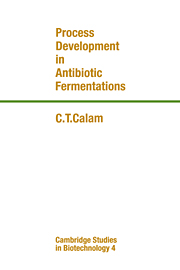Book contents
- Frontmatter
- Contents
- Preface
- Part 1 Background
- 1 Introduction
- 2 The microorganisms and methods of culture
- 3 Microbial Physiology
- 4 Microbial biochemistry
- 5 Subsidiary factors important in production fermentations
- 6 Submerged culture conditions: the interaction between environment and genotype
- Part 2 Process development in the laboratory
- Part 3 Industrial fermentation plants and pilot plants
- Postscript
- Bibliography
- References
- Index
- Frontmatter
- Contents
- Preface
- Part 1 Background
- 1 Introduction
- 2 The microorganisms and methods of culture
- 3 Microbial Physiology
- 4 Microbial biochemistry
- 5 Subsidiary factors important in production fermentations
- 6 Submerged culture conditions: the interaction between environment and genotype
- Part 2 Process development in the laboratory
- Part 3 Industrial fermentation plants and pilot plants
- Postscript
- Bibliography
- References
- Index
Summary
Origins of the development of antibiotic processes
Dr Alexander Fleming first observed penicillin in 1928. A contaminant colony of Penicillium notatum growing on an agar plate covered with bacterial colonies had brought about the lysis of all the colonies around it. In further culture experiments, the disinfecting effect of penicillin was confirmed, but the techniques available at the time were insufficient to enable it to be extracted and tested further. Ten years later, Florey and Chain, with a large team of scientists at Oxford, managed to prepare extracts and demonstrate their efficacy. As a result of this, production began in order to supply the material to the armed forces, and the first use in the field began in 1943 in North Africa. In 1945–6, as supplies increased, penicillin became generally available.
Professor L. P. Garrod, a leading bacteriologist, commented later that no other such trivial observation as that of Fleming has had such momentous consequences. Fifteen years afterwards the mould was being cultivated on a gigantic scale to produce a substance of unexampled power. There was no other chemotherapeutic agent that could be used with such a complete disregard for possible harmful effects. Although its action is selective, it could be used to treat diseases that previously could only be dealt with with difficulty or not at all. Along with the sulphonamides, available in 1935, it dealt with half the emergencies occurring in medicine; it completely transformed the outlook, reducing fatalities to a minimum.
The production of penicillin involved major efforts in process development, and these provide a useful introduction to the present book.
- Type
- Chapter
- Information
- Process Development in Antibiotic Fermentations , pp. 3 - 8Publisher: Cambridge University PressPrint publication year: 1987

